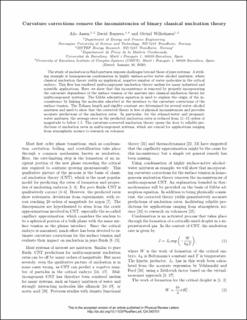| dc.contributor.author | Aasen, Ailo | |
| dc.contributor.author | Reguera, David | |
| dc.contributor.author | Wilhelmsen, Øivind | |
| dc.date.accessioned | 2020-08-27T06:55:58Z | |
| dc.date.available | 2020-08-27T06:55:58Z | |
| dc.date.created | 2020-01-29T16:58:46Z | |
| dc.date.issued | 2020 | |
| dc.identifier.issn | 0031-9007 | |
| dc.identifier.uri | https://hdl.handle.net/11250/2675288 | |
| dc.description.abstract | The study of nucleation in fluid mixtures exposes challenges beyond those of pure systems. A striking example is homogeneous condensation in highly surface-active water-alcohol mixtures, where classical nucleation theory yields an unphysical, negative number of water molecules in the critical embryo. This flaw has rendered multicomponent nucleation theory useless for many industrial and scientific applications. Here, we show that this inconsistency is removed by properly incorporating the curvature dependence of the surface tension of the mixture into classical nucleation theory for multicomponent systems. The Gibbs adsorption equation is used to explain the origin of the inconsistency by linking the molecules adsorbed at the interface to the curvature corrections of the surface tension. The Tolman length and rigidity constant are determined for several water-alcohol mixtures and used to show that the corrected theory is free of physical inconsistencies and provides accurate predictions of the nucleation rates. In particular, for the ethanol-water and propanol-water mixtures, the average error in the predicted nucleation rates is reduced from 11–15 orders of magnitude to below 1.5. The curvature-corrected nucleation theory opens the door to reliable predictions of nucleation rates in multicomponent systems, which are crucial for applications ranging from atmospheric science to research on volcanos. © 2020 American Physical Society | en_US |
| dc.language.iso | eng | en_US |
| dc.publisher | American Physical Society | en_US |
| dc.title | Curvature Corrections Remove the Inconsistencies of Binary Classical Nucleation Theory | en_US |
| dc.type | Peer reviewed | en_US |
| dc.type | Journal article | en_US |
| dc.description.version | acceptedVersion | en_US |
| dc.source.volume | 124 | en_US |
| dc.source.journal | Physical Review Letters | en_US |
| dc.source.issue | 4 | en_US |
| dc.identifier.doi | 10.1103/PhysRevLett.124.045701 | |
| dc.identifier.cristin | 1785552 | |
| dc.relation.project | Norges forskningsråd: 262644 | en_US |
| dc.description.localcode | © 2020. This is the authors' accepted and refereed manuscript to the chapter. | en_US |
| cristin.ispublished | true | |
| cristin.fulltext | postprint | |
| cristin.qualitycode | 2 | |
